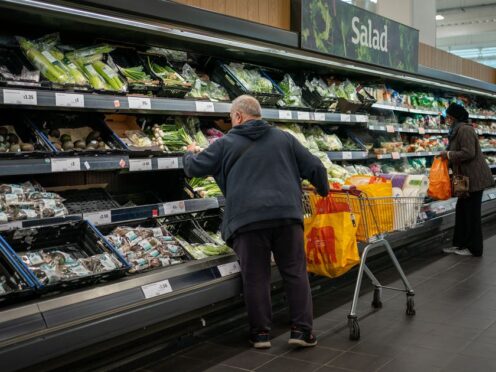Misleading and meaningless supermarket country-of-origin labels could be leaving shoppers struggling to find out where their food comes from, according to an investigation.
Loose cauliflowers, red cabbage, courgettes and onions at Sainsbury’s, peppers, melons and mangoes at Asda and spring onions at Aldi had no visible origin labelling on the shelf or the products themselves, researchers for Which? Found.
Tomatoes from Morocco, parsley from Italy and sweet mini peppers from Spain sat on a shelf under a large banner decorated with a Union Jack and the words “Championing Great British Quality” at the Aldi store visited by Which?
In one Asda, Which? found cauliflowers that had a Union Jack on the shelf label, but were actually from Spain.
Product labels had “fairly meaningless” information, such as a pack of sausage rolls from Lidl which stated they were processed using “UK and non-UK pork”, and a pack of gammon joints at Iceland where the pork was labelled as “EU and non-EU origin”.
Aldi’s Crestwood bacon and cheese wraps had Union Jacks and “Made in Britain” on the front of the pack, even as the label on the back of the pack said they were made with pork from the EU.
The same was found with an Aldi steak and gravy pie.
A survey of more than 2,000 UK consumers for the study found that just 51% of people find current origin information presented on groceries helpful.
Two thirds (64%) said they would be more likely to buy a product labelled “British” than one that was not.
Almost three quarters of consumers (72%) said it was important to know where fresh meat comes from, while 51% said they wanted to know where processed and tinned meat comes from.
Two thirds (68%) considered it important to know where fresh fruit and vegetables come from.
Current labelling rules require meat, fish, fresh fruit and vegetables, honey and wine to include a country or place or origin.
The rules do not generally apply to processed meat or frozen or processed fruit and vegetables.
There is a requirement to provide origin labelling if it would be misleading not to.
The survey also revealed that 59% of shoppers who check for origin labelling do it because they want to support their local economy, while 58% use it to help assess product quality and 52% use it to try to understand the product’s environmental impact.
Which? said origin labelling needed to be improved if it was to properly help shoppers make informed decisions that align with their values.
The watchdog said it would share its findings with the Department for Environment, Food and Rural Affairs for its consultation on fairer food labelling – which was launched on March 15.
Which? Retail editor Ele Clark said: “Which? research has uncovered a surprising amount of inconsistent and misleading food labelling, suggesting that – even when the rules are properly adhered to – consumers aren’t getting all the information they want about their food’s origin.
“Shoppers want to know where their food comes from for multiple reasons, including supporting British suppliers and making more sustainable choices.
“Supermarkets should particularly focus on labelling loose fruit and vegetables more clearly, but manufacturers and retailers should also consider providing origin information on more processed meat products so shoppers are armed with the information they need to make informed choices.”
An Aldi spokeswoman said: “We understand that our shoppers want to know where the food they buy comes from, and we work hard to ensure that all our labelling complies with the rules.
“When it comes to fresh fruit and veg, we are proud to support British farmers and aim to stock British produce whenever it’s available. Customers understand that at this time of year that isn’t always possible, but we remain firmly committed to supporting the British farming community.”
Asda said: “We have stringent processes in place to ensure country-of-origin is clearly displayed at the shelf edge and on products themselves where applicable, at all our stores.
“We have reminded our colleagues at this particular store of these processes so that customers are able to clearly see the country of origin.”
A spokesman for Iceland said: “At Iceland our products are great quality and value for customers and we follow UK government guidance on food labelling, including country-of-origin.”
A Sainsbury’s spokeswoman said: “We have processes in place to make sure country-of-origin information is clearly displayed on the product or shelf and we carry out regular checks working closely with our regulator, the Animal and Plant Health Agency.”
Deltapoll surveyed 2,011 UK adults online in February.
